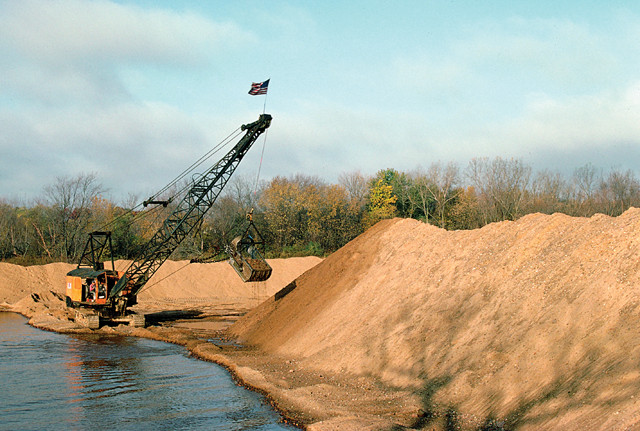
by U.S. Geological Survey Wednesday, June 13, 2018
Jason Christopher Willett, mineral commodity specialist for the U.S. Geological Survey, compiled the following information on construction aggregates, an abundant and important mineral resource.

Sand and gravel is one of the major types of natural aggregates. Credit: ©Marli Miller, University of Oregon, ESW Image Bank
Crushed stone and construction sand and gravel, the two major types of natural aggregates, are among the most abundant and accessible natural resources on the planet. The earliest civilizations used aggregates for various purposes, mainly construction. Today aggregates provide the basic raw materials for the foundation of modern society.
Aggregates have an amazing variety of uses: roads, bridges, streets, bricks, concrete, wallboard, roofing tiles, paint, glass, plastics, and even medicine. Every small town or big city and every road connecting them was built and is maintained with aggregates. More than 90 percent of asphalt pavements and 80 percent of concrete consist of aggregates.
Cement, the binder in concrete, is not technically an aggregate, but it is made from the same limestone that is used as aggregate in many construction projects. Ground limestone is also used in agriculture, medicine and household products.
Although crushed stone is used mainly in construction-related applications, industrial applications include manufacturing of glass, paint, paper and plastic. Aggregates increasingly are being used for environmental protection as well, such as in soil erosion-control programs, water purification, and reduction of sulfur dioxide emissions from coal-fired electric power plants.
Of the total amount of construction aggregates produced in the United States each year, on average, 42 percent is construction sand and gravel, 40 percent is crushed limestone and dolomite, 8 percent is crushed granite, and the rest is other types of crushed stone. About 85 percent of aggregates produced are used as construction aggregate, mostly for residential construction, highway construction and maintenance.
The widespread use of construction aggregates is the result of their general availability throughout the U.S. and around the world and their relatively low cost. Although construction aggregates have a low unit value, their widespread use makes them major contributors to, and indicators of, the economic well-being of nations.
In the U.S., on a tonnage-sold or -used basis, the aggregates industry accounts for about 90 percent of nonfuel minerals mined every year. The aggregates industry is active in all 50 states and consists of about 5,400 mining companies that manage more than 10,000 operations. Over the last 40 years, the leading crushed stone-producing state was Texas, followed by Pennsylvania, Florida, Illinois and Missouri. During the same period, the leading construction sand-and-gravel-producing state was California, followed by Texas, Michigan, Ohio and Arizona.
For more information on aggregates and other mineral resources, visit: minerals.usgs.gov/minerals.
Aggregates production and consumption
In 2010, the United States produced 1.96 billion metric tons of construction aggregates, valued at $17 billion.
World production of construction aggregates is estimated to be 25 billion metric tons, valued at $200 billion.
U.S. production of construction aggregates has decreased every year since 2006; in 2011, production was at the lowest level since 1992.
Fun facts
In the 1500s, Spanish settlers and soldiers quarried coquina limestone near St. Augustine, Fla., to form building blocks for their forts and homes.
The cumulative total production of construction aggregates since 1900 is 117 billion metric tons, 50 percent of which has been produced since 1985.
Thirty-one percent of all aggregates produced are used in residential construction; 26 percent are used in highway construction and maintenance.
In the United States, the per capita annual consumption of aggregates is 10 metric tons.
© 2008-2021. All rights reserved. Any copying, redistribution or retransmission of any of the contents of this service without the expressed written permission of the American Geosciences Institute is expressly prohibited. Click here for all copyright requests.